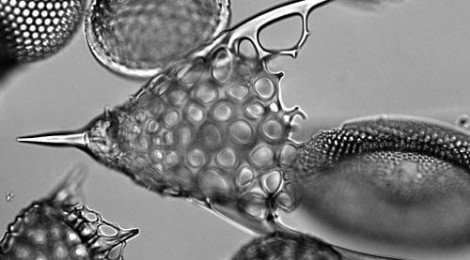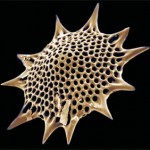
PROTEUS The Art Of Extraordinary Plankton
On the coast of Sicily, a man sits hunched over a microscope peering at what look to be grains of sand. It’s the late 1870s, and these specimens are mineral-shelled protozoans called radiolarians collected from the depths of the Marianas Trench by the HMS Challenger in science’s first attempt to take a census of marine life. Darwin had barely let the ink dry on his theory of natural selection, and most scientists did not believe that single-celled organisms even existed. But renowned German biologist and artist Ernst Haeckel (1834-1919) lived and breathed through his microscope, meticulously observing and sketching the silica skeletons of radiolarians and seeing in them nothing less than what he described as the “key to the creative power of nature.”
 Now fast-forward a century to the 1970s and imagine a man arranging these drawings of radiolarians under his flatbed camera and photographing them through a dot screen — as if he were observing these creatures anew with a passion not unlike Haeckel’s. “Perhaps we are equally obsessive wackos,” joked filmmaker David Lebrun, whose film, Proteus, transforms Haeckel’s drawings into a kaleidoscopic vision that animates the unity of science and art.
Now fast-forward a century to the 1970s and imagine a man arranging these drawings of radiolarians under his flatbed camera and photographing them through a dot screen — as if he were observing these creatures anew with a passion not unlike Haeckel’s. “Perhaps we are equally obsessive wackos,” joked filmmaker David Lebrun, whose film, Proteus, transforms Haeckel’s drawings into a kaleidoscopic vision that animates the unity of science and art.
This art is something worth looking at. It’s a rare experience.








